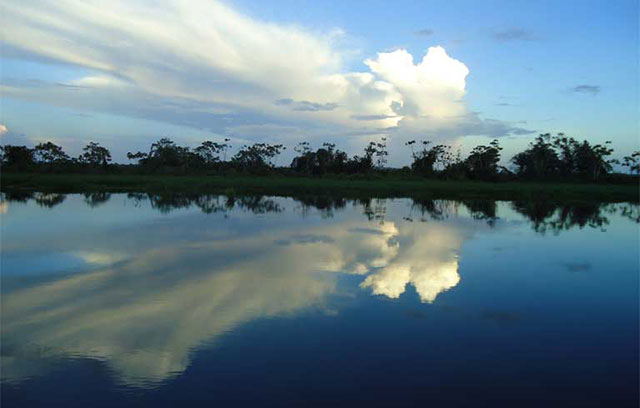
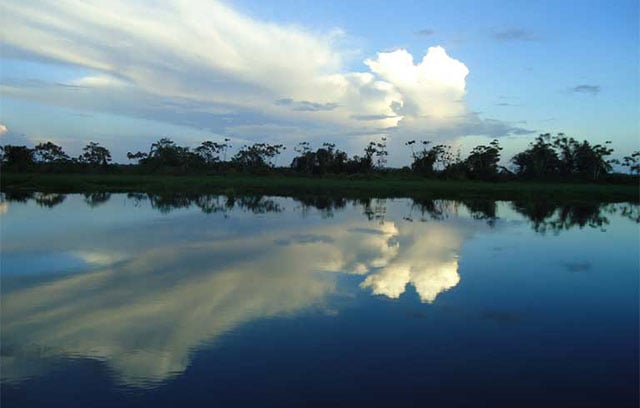 The Tapajós River, Brazil. More than 40 dams would turn this free-flowing river and its tributaries into a vast industrial waterway threatening the Tapajós Basin’s ecosystems, wildlife, people and even the regional and global climate. (Photo: International Rivers on Flickr, licensed under an Attribution-NonCommercial-ShareAlike 2.0 Generic (CC BY-NC-SA 2.0) license)
The Tapajós River, Brazil. More than 40 dams would turn this free-flowing river and its tributaries into a vast industrial waterway threatening the Tapajós Basin’s ecosystems, wildlife, people and even the regional and global climate. (Photo: International Rivers on Flickr, licensed under an Attribution-NonCommercial-ShareAlike 2.0 Generic (CC BY-NC-SA 2.0) license)
Brazil is forging ahead with plans to build a vast hydropower dam complex in the heart of the Amazon that would convert the now remote and wild Tapajós river system into a tamed industrial waterway for the purpose of transporting soybeans — development that scientists and NGOs say will threaten Amazonian biodiversity, ecosystems, traditional livelihoods, indigenous cultures, and the global climate.
A total of 42 large dams are planned or under construction in the Tapajós Basin, a biologically and culturally rich region, and one of eight areas of Amazonian biological endemism. Fed by tributaries in the states of Mato Grosso, Rondônia and Amazonas, the main stem of the Tapajós flows northeast through Pará state, and drains into the Amazon River at the city of Santarém. The Basin covers 189,962 square miles (492,000 square kilometers) and is more than twice the size of the UK.
Its forests and waterways are home to species such as the jaguar, giant otter, and river dolphin, as well as little-known and range-restricted species found nowhere else in the world. Many plants and animals here remain unknown to science. Traditional river communities and indigenous people rely upon the basin’s natural resources for their livelihoods.
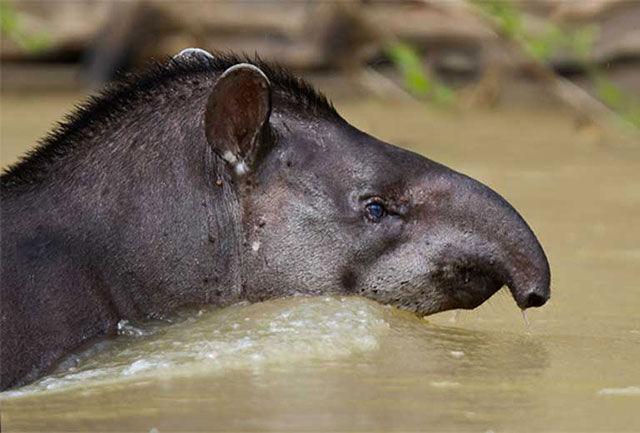 A lowland tapir (Tapirus terrestris) swimming across a river. This is just one of many threatened species in the Tapajós region, a vast area recognized as one the Amazon’s eight areas of biological endemism. (Photo © Tom Ambrose)
A lowland tapir (Tapirus terrestris) swimming across a river. This is just one of many threatened species in the Tapajós region, a vast area recognized as one the Amazon’s eight areas of biological endemism. (Photo © Tom Ambrose)
Dams are slated for construction on the Tapajós River, as well as on its principal tributaries, the Jamanxim, Juruena and Teles Pires rivers; the 7 major dams prioritized in Brazil’s 2013-2022 Ten Year Energy Expansion Plan for the Tapajós River and Teles Pires Basin would together put 1,479.5 square miles (3,831.9 square kilometers) underwater.
Amazon Scientists: “Effects Would Clearly Be Devastating”
The recent suspension of the largest of these, the São Luiz do Tapajós dam, was hailed as a conservation and human rights victory: if it remains unbuilt, then 280 square miles (722 square kilometers) of forest will be spared inundation. There is, however, concern that this dam won’t stay dead, with rumblings throughout Brazil’s Temer administration that the suspension of São Luiz do Tapajós will be reversed.
But no matter: there will be many severe impacts from the more than 40 other dams, especially when all of them are considered together, warns Philip Fearnside, an expert on Amazonian development and deforestation. Reservoirs flood forests, displace people, emit greenhouse gases (especially in the tropics), and disrupt the flow of water downstream and between river channels and floodplains.
In opening up barge and ship navigation from Mato Grosso state to the Amazon River and the Atlantic Ocean, the industrial waterway will promote the expansion of the soy industry, driving further major deforestation in the Amazonian interior. Negative interactions between dam construction, industry, and additional infrastructure — including major new roads and railways — coupled with human migration into the region, will trigger a cascade of indirect impacts on the forest ecosystem, unless plans are changed drastically to mitigate these impacts.
“The effects would clearly be devastating, both for the ecology and connectivity of the greater Tapajós Basin as well as for its diverse groups of indigenous peoples,” William Laurance, a professor at James Cook University, Australia, and a leading authority on tropical rainforest ecology, told Mongabay. “It is not overstating matters to term this a crisis in the making.”
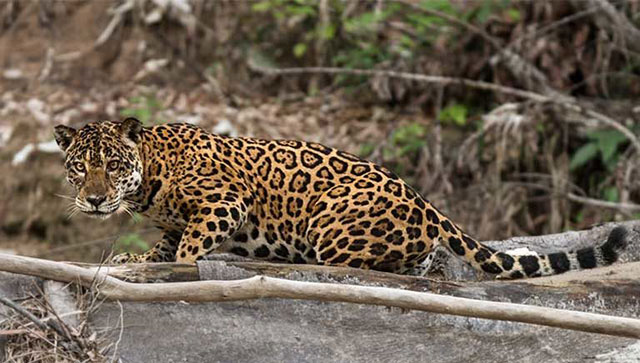 A female jaguar (Panthera onca) pauses on a riverbank. Even species that aren’t typically associated with rivers, such as jaguars, make use of riverbanks to hunt for prey. (Photo © Tom Ambrose)
A female jaguar (Panthera onca) pauses on a riverbank. Even species that aren’t typically associated with rivers, such as jaguars, make use of riverbanks to hunt for prey. (Photo © Tom Ambrose)
Stewart Maginnis, global director of IUCN’s Nature-based Solutions Group, and former director of its Forest and Climate Change Program, shares this concern: “The impacts on freshwater biodiversity, indigenous people, and the opening up of new areas for agriculture bring the risk of further deforestation and land-use changes in the Amazon Basin.”
Despite the immensity of these potential impacts, the public is still mostly unaware of the “complexity and ambitions” of the plans in the Tapajós, says prominent Amazon conservation biologist Thomas Lovejoy, director of the Center for Biodiversity and Sustainability at George Mason University, and senior fellow at the UN Foundation.
Plan Benefits Construction Firms, Energy Industry and Agribusiness
One factor driving the so-called “Tapajós Complex” forward is the Brazilian government’s appetite for hydroelectric energy production and for funding big infrastructure projects.
Fearnside argues that these national energy needs have not only been “greatly exaggerated,” but that they could easily be met by alternative power sources. “The projections [of Brazil’s future energy needs] ignore all limits, [and forecast] astronomical electricity use within a few years,” statistics that are then used to justify the planned hydroelectric projects, he says.
The building of mega-dams (including the recently completed but controversial Belo Monte Dam) has hugely benefited Brazil’s gigantic construction firms, along with the nation’s ruling political parties, who in the past have received very generous campaign contributions from contract-winning companies.
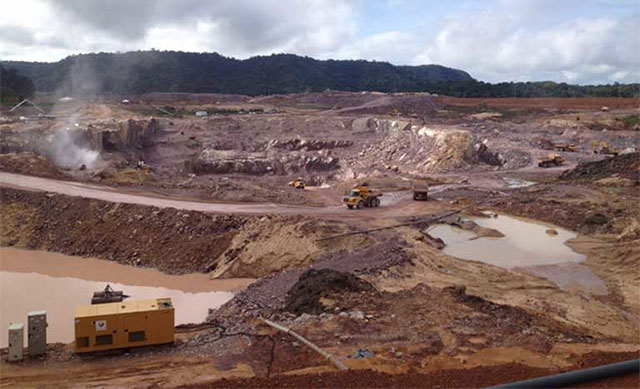 Construction is already underway at the São Manoel dam site on the Teles Pires river, with three other dams completed or nearing completion. The Teles Pires is a major tributary of the Tapajós River. (Photo by International Rivers on Flickr, licensed under an Attribution-NonCommercial-ShareAlike 2.0 Generic (CC BY-NC-SA 2.0) license)
Construction is already underway at the São Manoel dam site on the Teles Pires river, with three other dams completed or nearing completion. The Teles Pires is a major tributary of the Tapajós River. (Photo by International Rivers on Flickr, licensed under an Attribution-NonCommercial-ShareAlike 2.0 Generic (CC BY-NC-SA 2.0) license)
“The first priority [for Brazil should be] to use less electricity,” argues Fearnside, a professor at Brazil’s National Institute of Research in the Amazon (INPA). And if the country needs to move beyond energy efficiency to increase production, then “Brazil has enormous potential for wind and solar power.”
Another driving force behind the Tapajós Dam Complex is the “tremendous pressure” from the soy industry, which stands to reap major benefits from the cheap improved transportation afforded by the industrial waterway. That is coupled with the importance of soy exports to the Brazilian economy, significance vastly magnified by the current urgency of Brazil’s severe economic crisis.
Together, these factors mean that “there is much political willingness to facilitate [Tapajós development] regardless of the consequences” asserts Fearnside. Links between government and agribusiness are stronger than ever, with one of Brazil’s largest soy planters, Blairo Maggi, recently appointed as the Minister for Agriculture. “The largest of the Maggi family’s 12 properties would be served by the first branch of the planned waterway, the Teles Pires branch,” Fearnside notes.
Because hydroelectric projects facilitate lock-building and the flooding of otherwise impassable rapids, the 40+ new dams are inextricably linked with, and vital to, the planned industrial waterway. Laurance and Fearnside see the resulting “all-or-nothing” approach to dam construction as especially dangerous. Without the need for the industrial waterway some hydroelectric dams might not be a priority for the government at all.
In the Name of National Security
A major concern in the Tapajós Basin is that the government will turn a blind eye to potential social and ecological impacts, bulldozing a path forward. In the past, the Brazilian government has repeatedly used national “security suspensions” as a means of overturning environmental licensing restrictions and thwarting social resistance to major infrastructure projects including dams, opting instead for economic growth — which is deemed a national security imperative.
This legal provision is a holdover from Brazil’s 1964-1985 military dictatorship. Indeed, the “security suspension” provision has already been used to make way for four new dams already under construction on the Teles Pires River, a Tapajós tributary. Though a judge ordered two of those dams stopped, the decision was overruled via a “security suspension.”
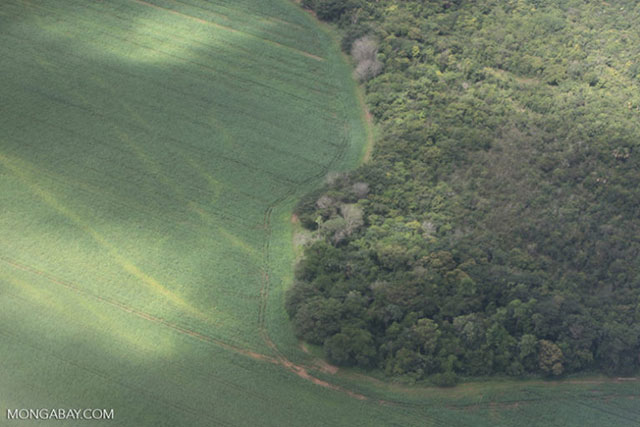 Soy and forest in the Brazilian Amazon. The soy industry will be one of the main beneficiaries of the Tapajós industrial waterway, which will open up barge and ship navigation between Mato Grosso state, the Amazon River, Atlantic ports and beyond. Because dams facilitate lock-building, and the flooding of formerly impassable rapids, they and their reservoirs are inextricably linked with the plans for the waterway. Scientists are concerned about the resulting “all or nothing” approach to this rapid infrastructure development. (Photo by Rhett A. Butler)
Soy and forest in the Brazilian Amazon. The soy industry will be one of the main beneficiaries of the Tapajós industrial waterway, which will open up barge and ship navigation between Mato Grosso state, the Amazon River, Atlantic ports and beyond. Because dams facilitate lock-building, and the flooding of formerly impassable rapids, they and their reservoirs are inextricably linked with the plans for the waterway. Scientists are concerned about the resulting “all or nothing” approach to this rapid infrastructure development. (Photo by Rhett A. Butler)
Meanwhile numerous measures are being moved through the Brazilian Congress that, if passed, could fast track the dams. In addition, the government — apparently in preparation for Tapajós Complex construction — has in recent years quietly reduced the size of major federally protected areas along the region’s rivers, eliminating protections to floodplains in order to anticipate and prevent any legal conflict with the dams and their reservoirs when the projects were finally initiated.
The fear among NGOs and indigenous groups is that government officials are setting the stage to quickly green light dam construction throughout the Tapajós Basin. “Governmental indifference, bordering on hostility, to the natural systems in the earth’s last large tropical forest ecosystem is nothing short of outrageous,” says Lawrence Hurd, a professor at Washington and Lee University, USA.
Hydrological Impacts
One of the most immediate and direct effects of any dam is the obstruction of water: downstream flow, seasonal fluctuations, and natural flood pulses are all diminished and controlled by dams and reservoirs — doubly so in rainforests which can fluctuate between very wet flood seasons, and very dry seasons with low water.
Dams interrupt essential natural connections, blocking the flow of nutrients, sediments, and aquatic life between headwaters and river channels downstream, and across floodplains.
“Hydrological connections sustain the ecological, economic and cultural integrity of the Tapajós River system,” Woods Hole Research Center, USA, scientist Marcia Macedo explains. “The Tapajós Hydroelectric Complex would fundamentally change the flow of water” in the basin.
Michael Coe, an earth system scientist also at Woods Hole, sees the “complete re-engineering of the free-flowing river system” as a real cause for concern, because “even very small changes in flow timing and magnitude can cause very large changes in ecosystem processes. In particular, I worry about the health and viability of the riparian zones along these rivers,” says Coe.
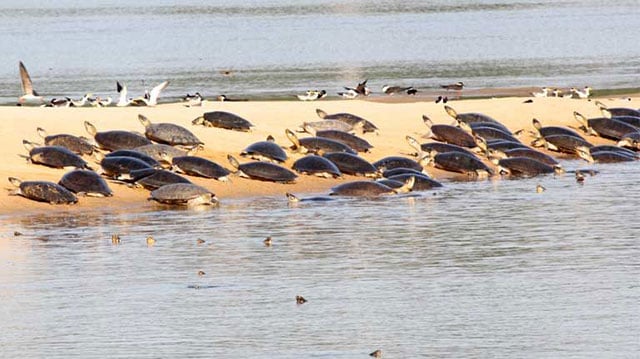 A nesting beach used by the Giant Amazon River Turtle (Podocnemis expansa). The reservoirs created by Tapajós Basin dams will flood hundreds of square miles, and radically alter the flow of water within the river systems. Aquatic and floodplain habitats will be altered and destroyed, including nesting beaches such as this one. (Photo by Camila Ferrara)
A nesting beach used by the Giant Amazon River Turtle (Podocnemis expansa). The reservoirs created by Tapajós Basin dams will flood hundreds of square miles, and radically alter the flow of water within the river systems. Aquatic and floodplain habitats will be altered and destroyed, including nesting beaches such as this one. (Photo by Camila Ferrara)
Another impact of blocked flow: the concentration of methylmercury in reservoirs, and downstream from reservoirs — a partial result of the mercury that is used in gold mining in the Amazon. Once consumed by fish, the toxin bio-accumulates up the food chain; those at the top, such as large predators and people, consume the highest quantities of this toxic metal which poses a serious health risk. Amazon dams have sometimes shown dangerous levels of methylmercury — a real risk on the Tapajós, which already sees high concentrations of this toxic compound in some parts of the river.
All of these negative hydrological impacts are compounded and magnified when multiple dams are built in series along the same river, or in a river system, which would happen all across the Tapajós Complex.
But despite these clear cumulative impacts being “much larger than the sum of the parts” as Coe puts it, threats are always evaluated by the government on a dam-by-dam basis, and cumulative impacts are not considered.
Many scientists argue that for the Tapajós Complex to be evaluated properly, all the dams must be analyzed together and in advance, in order to gain a clear perspective regarding the cumulative environmental effects of altered flows.
Biodiversity Impacts
The hydrological changes wrought by the construction of the Tapajós dams will have profound effects on the species living within the freshwater ecosystem: connectivity is crucial for healthy and genetically diverse populations.
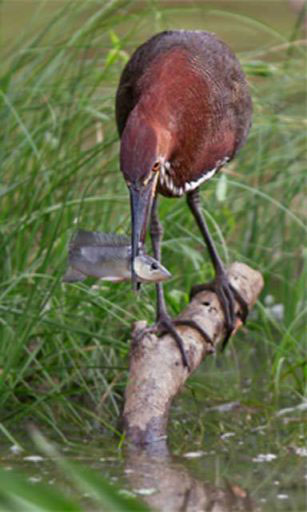 A rufescent tiger heron (Tigrisoma lineatum) caught in the act. Species such as this will see both their habitat and their fish prey impacted by dam construction. (Photo © Tom Ambrose)“It is easy to predict the overall impact of dams on fish species communities: diversity will decrease both above and below the dams, some species will go extinct locally and, because tropical fish often have limited ranges of occurrence, regionally as well,” Hurd, who studies tropical fish diversity, told Mongabay.
A rufescent tiger heron (Tigrisoma lineatum) caught in the act. Species such as this will see both their habitat and their fish prey impacted by dam construction. (Photo © Tom Ambrose)“It is easy to predict the overall impact of dams on fish species communities: diversity will decrease both above and below the dams, some species will go extinct locally and, because tropical fish often have limited ranges of occurrence, regionally as well,” Hurd, who studies tropical fish diversity, told Mongabay.
Mitigating these impacts is all but impossible, he explains. That’s why he sees the development of the Tapajós as a looming “environmental disaster.” Dams change water flow, depth, temperature, sedimentation, and oxygen levels, and Amazonian “[f]ish species are exquisitely adapted to these environmental characteristics.”
The dams would also act as barriers to movement and migration, making annual spawning runs upstream impossible for many species, says WWF-Brazil’s science program coordinator Mariana Napolitano Ferreira. Dam-obstructed migration has already been documented for giant catfish elsewhere in the Amazon basin. Although some efforts to incorporate fish ladders into dams have been made in the past, these have not been successful. And even if fish are able to somehow return upstream to spawn, juvenile fish coming back downstream may find their way past dams impassable.
Changes in fish populations will be felt by their predators, including two species of river dolphin, says researcher Claryana Araújo, of the Federal University of Goiás, Brazil. Freshwater dolphins also risk population fragmentation and isolation by some of the planned dams, she says.
Turtles will lose habitats and nesting beaches to dam reservoirs. “[I]nundating such massive areas of forest will destroy the populations of 11 species of turtles,” with 6 facing complete extirpation due to the destruction of their foraging habitat and nesting areas, Richard Vogt, turtle conservationist at INPA, told Mongabay.
Some species, such as the giant Amazon river turtle (Podocnemis expansa) migrate hundreds of kilometers to return to their historic nesting beaches over their 80-100 year lifespans, Vogt explains, so “destroying these sites will affect the integrity of these populations” and “disrupt the ability of these species to find mates.”
 A pair of capped herons (Pilherodius pileatus). The connectivity of the Amazon’s freshwater habitats is crucial for aquatic species, but is threatened by dam construction which diminishes the flood cycles that naturally inundate the floodplain. (Photo © Tom Ambrose)With Tapajós Basin reservoirs putting thousands of hectares of forest underwater, hundreds of species living on river islands, along riverbanks, and within the floodplain forest would see their habitat disappear. Numerous protected conservation areas and their forests and wetlands would be affected too.
A pair of capped herons (Pilherodius pileatus). The connectivity of the Amazon’s freshwater habitats is crucial for aquatic species, but is threatened by dam construction which diminishes the flood cycles that naturally inundate the floodplain. (Photo © Tom Ambrose)With Tapajós Basin reservoirs putting thousands of hectares of forest underwater, hundreds of species living on river islands, along riverbanks, and within the floodplain forest would see their habitat disappear. Numerous protected conservation areas and their forests and wetlands would be affected too.
Threatened species in the region include the giant armadillo (Priodontes maximus), giant anteater (Myrmecophaga tridactyla), white-cheeked spider monkey (Ateles marginatus), and oncilla, or little spotted cat (Leopardus tigrinus).
Construction of the Tapajós Complex would also see the “[d]irect loss of habitat for many bird species,” Alexander Lees, an ornithologist at Cornell University, USA, told Mongabay. “The region is home to a suite of restricted range bird species, all of which are poorly known and already at risk of global extinction because of forest loss.”
Those at greatest risk include the Golden-crowned Manakin (Lepidothrix vilasboasi); the Tapajós Hermit (Phaethornis aethopygus); the Tapajós Scythebill (Campylorhamphus cardosoi), which was only recently described by science; and the Cone-billed Tanager (Conothraupis mesoleuca) “which remains Critically Endangered and very poorly known,” Lees says.
Once indirect deforestation is taken into account — due to the building of dam service roads, electric transmission lines, plus towns to support construction workers — habitat loss and fragmentation becomes even more serious.
Laurance, who has studied the impacts of road construction on deforestation, sees this indirect impact as an even greater threat to forest cover than the dams themselves. “Such roads frequently open a Pandora’s Box of illegal activities, such as forest encroachment, wildfires, poaching, illegal logging, that are highly destructive to forests and wildlife,” he states.
Social and Economic Impacts
For the many thousand people belonging to indigenous groups and traditional riverine communities in the Basin, rivers and forests are central to their way of life, and the Tapajós Complex will bring unwelcome change. But even people living in cities are being affected by the vast undertaking. The cities of Santarem and Itaituba have, for example, already been impacted as soy port infrastructure has been put in place, bringing new jobs, but also adding to urban problems such as pollution, crime and overcrowding.
 Indigenous Munduruku living on the Teles Pires River taking part in a mapping workshop. Indigenous people and river communities have seen, and will continue to see, territory lost, fisheries disrupted and depleted, and food security diminished, with the construction of the Tapajós Complex dams. (Photo by International Rivers on Flickr, licensed under an Attribution-NonCommercial-ShareAlike 2.0 Generic (CC BY-NC-SA 2.0) license)
Indigenous Munduruku living on the Teles Pires River taking part in a mapping workshop. Indigenous people and river communities have seen, and will continue to see, territory lost, fisheries disrupted and depleted, and food security diminished, with the construction of the Tapajós Complex dams. (Photo by International Rivers on Flickr, licensed under an Attribution-NonCommercial-ShareAlike 2.0 Generic (CC BY-NC-SA 2.0) license)
The Chacorão Dam alone, on the Tapajós River, “would flood 11,700 hectares [45 square miles] in the Munduruku Indigenous Land”, reveals Fearnside, who recently highlighted a series of actions taken by the government to chip away at legal restrictions on big infrastructure projects, threatening indigenous territories.
In an earlier interview for Mongabay, Brent Millikan, the Amazon Program Director at the NGO International Rivers, said that the socio-environmental conflicts associated with the Tapajós Complex “have been closely associated with chronic violations of human rights and environmental legislation, the undermining of democratic institutions, authoritarianism and, ultimately, rampant corruption.”
“A human rights crisis, driven by the flooding of indigenous territories and forced relocation of indigenous villages — which is illegal under Brazil’s constitution — would be exacerbated by the loss of fisheries, reduced fertility of fertile floodplains, and polluting of clean water sources,” says Amazon Watch’s Christian Poirier.
The “grim consequences” of hydropower development for fish, turtles and mammals have knock-on effects on the human population, as these species “form the basis of local food security and livelihoods” for resident communities, Poirier notes.
Hurd elaborated further, saying that migratory fish are both “the most important source of protein for regional human populations” and “perhaps the most immediately vulnerable victims of dam construction.” These fish also form the basis for regional commercial fisheries in the Tapajós Basin. Their loss would force the Basin’s human population to look elsewhere to meet its protein needs.
Camila Jericó-Daminello, a research analyst with the Conservation Strategy Fund (CSF), studied the possible economic impacts of just one of the dams, the São Luiz do Tapajós project, were it to go ahead. “Considering negative economic impacts on household incomes, water provision, and climate regulation, the environmental costs associated with the project, but not formally accounted for [in official environmental assessments], are at least BRL $1.9 billion (USD $590 million) considering a 30 year timeframe,” she observes.
“Despite the scale of these costs, almost no information about the dam had until recently been shared with civil society and local populations,” says Jericó-Daminello.
 The main stem of the Tapajós River, one of the last great undammed rivers of the Amazon. When combined with the Juruena River, it flows for roughly 1,200 miles through the heart of the Amazon rainforest. Scientists continue to discover species that are new to science here. An Environmental Impact Assessment for just one proposed dam uncovered eight new mammal species. (Photo by Zoe Sullivan)
The main stem of the Tapajós River, one of the last great undammed rivers of the Amazon. When combined with the Juruena River, it flows for roughly 1,200 miles through the heart of the Amazon rainforest. Scientists continue to discover species that are new to science here. An Environmental Impact Assessment for just one proposed dam uncovered eight new mammal species. (Photo by Zoe Sullivan)
Although São Luiz do Tapajós is currently on hold, these financial predictions hint at the astronomical economic costs if the remaining 40+ dams are constructed. The full social and economic price of the Tapajós Complex have yet to be analyzed, and no overall evaluation has ever been put before the people most likely to be impacted.
As Isabel Rosa, a researcher at the German Center for Integrative Biodiversity Research notes, Brazil has a large indigenous population deeply reliant on the Amazon rainforest: “If the Brazilian legal system is not doing its job in protecting its citizens’ interests, who will?”
Climate Impacts
Although dams are traditionally promoted as clean energy sources, there is increasing recognition among scientists and policymakers that hydropower reservoirs (especially in the tropics) are far from green: carbon dioxide and methane — a greenhouse gas more than 20 times as potent as CO2 — are both released in significant amounts from organic matter in submerged soils and decaying vegetation.
The Amazon’s living forest usually acts as a carbon sink, sequestering CO2 and keeping it out of the atmosphere. “Accelerated forest loss” due to reservoirs and further forest clearance for roads, from illegal logging and other causes, will therefore “have significant impacts in terms of carbon emissions,” Rosa notes. Coe adds that “Brazil’s contribution to global climate change” would increase as a result.
“The worst-case scenario indicates an indirect effect of infrastructure development [in the Tapajós] of over 200,000 square kilometers [77,220 square miles] of deforestation,” reveals climatologist Carlos Nobre, program scientist of Brazil’s National Institute for Climate Change, which would be “very serious,” with “some level of regional climate change, such as increased temperatures,” expected if deforestation on this scale takes place.
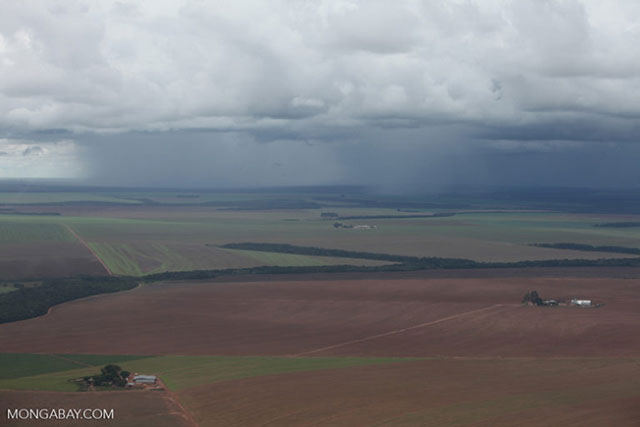 A storm over an agricultural landscape in the Braziliam Amazon. The Amazon forest generates more than half of its own rainfall, and deforestation affects the way water is recycled into the atmosphere, with forest clearance leading to more drought. Scientists warn that the local and global climate could be affected by the Tapajós Complex. (Photo by Rhett A. Butler)
A storm over an agricultural landscape in the Braziliam Amazon. The Amazon forest generates more than half of its own rainfall, and deforestation affects the way water is recycled into the atmosphere, with forest clearance leading to more drought. Scientists warn that the local and global climate could be affected by the Tapajós Complex. (Photo by Rhett A. Butler)
Scientists know that the loss of forest cover changes the way water cycles through an ecosystem, with less water returned to the atmosphere. Because the Amazon generates much of its own rain through this evapotranspiration process, major deforestation can lead to rainfall reductions, and, in the extreme, to severe drought.
These rainfall losses won’t only be felt in the Amazon: ‘Well over half of the rain that falls over Southern Brazil [beyond the Amazon’s boundaries] is originally put into the atmosphere by trees in the Amazon Basin,” says Abby Swann, a scientist studying the links between ecosystems and climate at Washington University, USA.
One consequence of this forest clearance/reduced rainfall relationship is significantly lower river levels, which would reduce the generating capacity and economic viability of the hydropower dams that triggered the deforestation in the first place.
The outlook over the longer-term is uncertain, but these climatic impacts could be devastating, not just for Brazil but for our planet.
“I think the Amazon is pretty close, at 20 percent deforestation, to the tipping point of unraveling the hydrological cycle right now,” said Amazon researcher Lovejoy. “The historic droughts of 2005 and 2010, and the drought this year, are, I believe, early flickers and warnings.”
Lovejoy sees the combined deforestation impacts of the Tapajós Complex as potentially sufficient to “push the system beyond the tipping point,” meaning that rainfall levels would decrease to the extent that they could no longer maintain the current Amazon ecosystem. The rainforests would begin to die.
If that happens, another tipping point is of concern to scientists: the time at which the Amazon rainforest as a whole stops sucking carbon dioxide from the atmosphere and ceases being a carbon sink, and instead becomes a carbon source, sending the greenhouse gases long held in its trees into the sky.
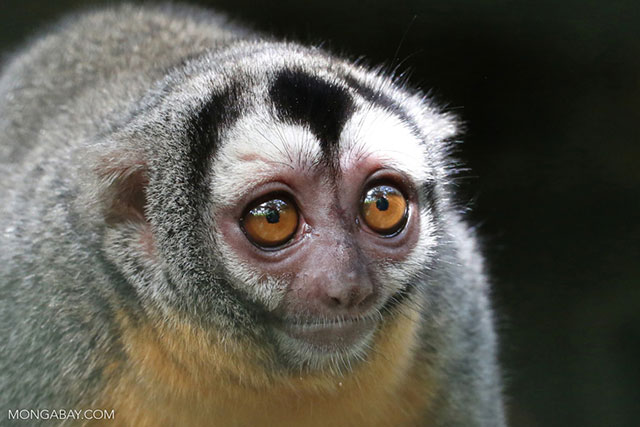 A night monkey (Aotus sp.). With the coming of dams, indirect deforestation due to additional infrastructure (transmission lines, roads, enlarged settlements, etc.), pose an even greater threat to forest cover than the dams and reservoirs themselves. Amazon dams and the roads they spawn also increase access for illegal loggers. Rainforest wildlife suffer widespread habitat loss and fragmentation as a result. (Photo by Rhett A. Butler)
A night monkey (Aotus sp.). With the coming of dams, indirect deforestation due to additional infrastructure (transmission lines, roads, enlarged settlements, etc.), pose an even greater threat to forest cover than the dams and reservoirs themselves. Amazon dams and the roads they spawn also increase access for illegal loggers. Rainforest wildlife suffer widespread habitat loss and fragmentation as a result. (Photo by Rhett A. Butler)
Alarmingly, indications of such a shift are already showing up, even without the massive deforestation projected for the Tapajós Basin. Record 21st century droughts have temporarily shut down the Amazon carbon sink — another example of those SOS “flickers and warnings” coming from the Amazon ecosystem. A permanent shutdown would have huge implications for the global climate, but predicting when this tipping point will be reached is not easy. “[T]here is still a lot of uncertainty in how tropical forests are, and will, respond to climate change,” Swann emphasizes.
Nobre’s studies indicate that the threshold may lie not close to 20 percent deforestation as Lovejoy suggests, but at 40 percent deforestation. “From that perspective, one should be cautious not to encourage further deforestation because there are other drivers of change [that are] also reasons of concern,” he says. For example, warming of 4 degrees Celsius would also trigger serious feedbacks within the forest system, so “unchecked global warming presents a great danger of reaching a tipping point.”
The truth is that our science isn’t yet robust enough to know precisely where these tipping points are. But scientists like Lovejoy and Nobre warn that our wholesale destruction of Amazon forests is playing with fire. In a recent interview, when asked what he saw as the greatest threat to the Amazon, Lovejoy responded: “The intersection between uncoordinated infrastructure and the hydrological cycle.”
Calls for Action
Scientists and NGOs say that Brazilian hydropower development needs to change in two major ways if this “crisis in the making” is to be averted. First, the infrastructure licensing process must be strengthened, not weakened. Second, the cumulative effects of multiple dam development across entire drainage basins must be considered and respected during the planning process.
“The biggest policy priority for freshwater conservation in the Amazon is restructuring the legal process for approval of large hydroelectric projects like the Tapajós Dam Complex,” Macedo says.
“Social and environmental externalities need to be included in cost benefit analyses and used during decision making processes,” Jericó-Daminello adds. “Indigenous people’s rights must also be recognized, including [their] involvement throughout the licensing process and in providing consent (or not!) for projects.”
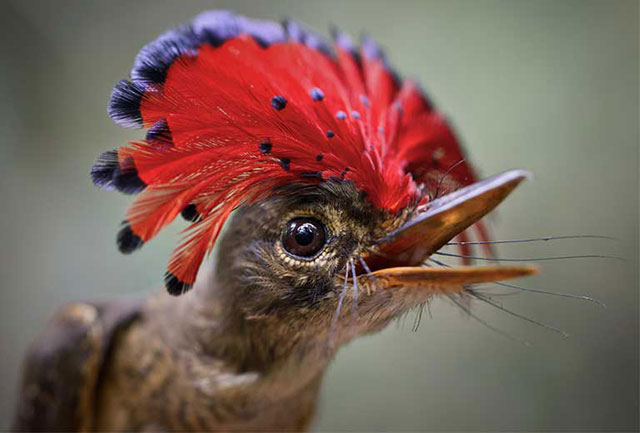 A royal flycatcher (Onychorhynchus coronatus). Scientists urge Brazil to take an integrated, basin-wide approach to hydropower development in the Amazon, and to pursue alternatives to hydropower for energy production in order to protect the region’s vast web of life. (Photo © Tom Ambrose)
A royal flycatcher (Onychorhynchus coronatus). Scientists urge Brazil to take an integrated, basin-wide approach to hydropower development in the Amazon, and to pursue alternatives to hydropower for energy production in order to protect the region’s vast web of life. (Photo © Tom Ambrose)
Fearnside sees a vigorous defense of the existing dam licensing process against the many attacks now underway in Brazil’s Congress as an urgent priority. “Despite its many problems, [the licensing system] is essential to keeping consideration of environmental and social impacts in the picture, as shown by the recent archiving of the São Luiz do Tapajós [dam],” he asserts.
Especially alarming to Fearnside and others is that the Congress, partly under the aegis of Agriculture Minister Maggi, has gone so far as to propose a constitutional amendment (PEC 65) that would essentially gut environmental and indigenous protections.
Integrated, basin-wide assessments of dam impacts, and the maintenance of free-flowing rivers within watersheds, are just some of the approaches scientists are urging Brazil to adopt. “It is of fundamental importance that the set of dams now being planned should be assessed as a set,” says WWF-Brazil, in a report outlining their conservation vision for the Tapajós basin.
Scientific tools exist to facilitate this approach, which could form “part of a proactive planning process for Brazil’s energy infrastructure,” says Jericó-Daminello, pointing to CSF’s Hydrocalculator Tool, which includes evaluation of the social, economic and climate implications of proposed infrastructure developments — an analysis that can be performed to include and compare multiple projects. Using this tool during the planning stage “would greatly improve environmental and likely economic impacts.”
But ultimately, a shift from hydropower to other sources of energy production is called for, say experts: “Alternatives exist that allow the country to have a diversified energy matrix that is clean and secure and that would be competitive from the economic and environmental standpoint,” WWF-Brazil states in their report.
“What is needed is forest restoration not further deforestation,” concludes Lovejoy. “I think it is time to rethink the plans for Amazon energy.”
Join us in defending the truth before it’s too late
The future of independent journalism is uncertain, and the consequences of losing it are too grave to ignore. To ensure Truthout remains safe, strong, and free, we need to raise $47,000 in the next 8 days. Every dollar raised goes directly toward the costs of producing news you can trust.
Please give what you can — because by supporting us with a tax-deductible donation, you’re not just preserving a source of news, you’re helping to safeguard what’s left of our democracy.